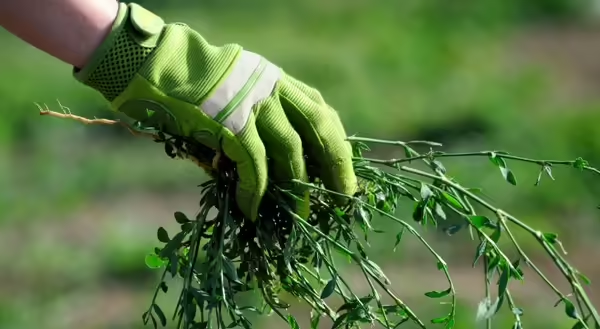
As the growing season begins in Illinois, it is not just our crops that will be sprouting. Growers should soon begin monitoring their fields for agricultural weeds and making plans to manage them.
What is a weed?
A weed is any plant that is growing where it is not wanted. For farmers, this is often any plant besides the one they planted. Weeds are at best a nuisance and at worst a major economic threat that can cause significant declines in crop production. Weeds affect our crops’ ability to thrive by competing with them for resources like sunlight, nutrients, water, and space. Weeds can also be a breeding ground for fungal diseases and pests. Some other common weediness traits are prolific seed production and rapid growth.
When should growers start worrying about weeds?
Different weeds emerge at different times throughout the growing season, so it is important that growers are continuously scouting their fields to be aware if and when weeds are becoming a problem. Weeds can be separated into five different groups based on their emergence date:
Group 0: Emerge in fall or early spring.
Example: Horseweed (marestail), Field pennycress
Group 1: Emerge several weeks before corn is planted.
Example: Giant ragweed, Lambsquarters
Group 2: Emerge right before or at the same time as corn planting.
Example: Velvetleaf, Common ragweed
Group 3: Emerge at the end of corn planting season.
Example: Black nightshade, Yellow foxtail
Group 4: Emerge after corn begins to emerge.
Example: Waterhemp (pigweed), Palmer amaranth
Emergence patterns in weeds determine the types of problems a weed can present and what growers can do to combat them. Two weeds that have given growers a lot of problems recently are Waterhemp and Palmer amaranth. Both weeds are commonly referred to as “pigweeds” and are members of the family Amaranthaceae. Waterhemp did not begin causing serious problems for growers until the 1980s, when it began to develop herbicide resistance. Now populations of Waterhemp have evolved resistance to six different classes of herbicides. It is a similar story for Palmer amaranth, with this weed having evolved resistance to eight herbicide sites of action and some populations have evolved resistance to multiple sites of action. One population of Palmer amaranth in Illinois even has a 6-way resistance. Palmer amaranth is particularly frustrating for farmers as it grows quickly, is highly competitive, and emerges throughout the growing season. These two weeds have similar appearances, making early identification crucial to successful management.
What information should growers know about common weeds?
Growers should be familiar with the weeds that are common in our area and their growth habits. This includes information about seedling emergence, whether it is annual or perennial, when it goes to seed and the typical control methods. Growers should scout their fields regularly and identify problem weeds as early as possible.
University of Illinois Extension Commercial Agriculture Educator Kathryn Seebruck emphasizes the importance of early scouting: “The importance of scouting can’t be overstated. Knowing which species are present in your fields and understanding their life cycles, growth habits, and weediness traits is essential to determining the best management practices to control them.”
Iowa State University Extension and University of Minnesota Extension both offer online resources to help growers identify and manage weeds.
Emily Hansen is a Commercial Agriculture Educator with University of Illinois Extension, serving Bureau, LaSalle, Marshall, and Putnam counties. Emily provides research-based educational programs that empower growers to make sustainable choices on their farms.
Hager, A. "Is it Waterhemp or Palmer Amaranth?." Department of Crop Sciences, University of Illinois at Urbana-Champaign, June 5, 2013.
Hager, A., & University of Illinois Extension. (2022). Chapter 12: Weed Management. In Illinois Agronomy Handbook.
Iowa State University Extension. (n.d.). Waterhemp | Integrated Crop Management. Retrieved March 4, 2024, from https://crops.extension.iastate.edu/encyclopedia/waterhemp
Iowa State University Extension. (n.d.). Palmer amaranth | Integrated Crop Management. Retrieved March 4, 2024, from https://crops.extension.iastate.edu/encyclopedia/palmer-amaranth-id-biology-and-management